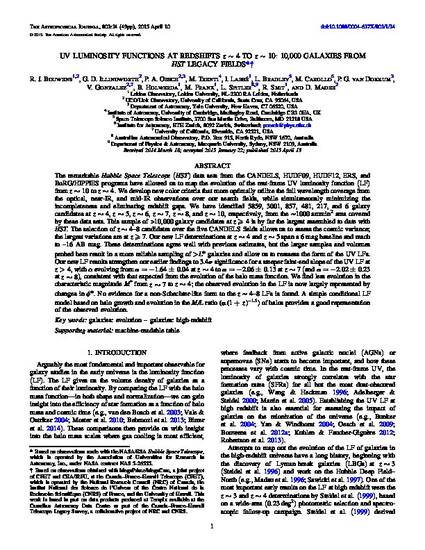
The remarkable Hubble Space Telescope (HST) data sets from the CANDELS, HUDF09, HUDF12, ERS, and BoRG/HIPPIES programs have allowed us to map the evolution of the rest-frame UV luminosity function (LF) from z ~ 10 to z ~ 4. We develop new color criteria that more optimally utilize the full wavelength coverage from the optical, near-IR, and mid-IR observations over our search fields, while simultaneously minimizing the incompleteness and eliminating redshift gaps. We have identified 5859, 3001, 857, 481, 217, and 6 galaxy candidates at z ~ 4, z ~ 5, z ~ 6, z ~ 7, z ~ 8, and z ~ 10, respectively, from the ∼1000 arcmin2 area covered by these data sets. This sample of >10,000 galaxy candidates at z ⩾ 4 is by far the largest assembled to date with HST. The selection of z ~ 4–8 candidates over the five CANDELS fields allows us to assess the cosmic variance; the largest variations are at z ⩾ 7. Our new LF determinations at z ~ 4 and z ~ 5 span a 6 mag baseline and reach to –16 AB mag. These determinations agree well with previous estimates, but the larger samples and volumes probed here result in a more reliable sampling of >L* galaxies and allow us to reassess the form of the UV LFs. Our new LF results strengthen our earlier findings to 3.4s significance for a steeper faint-end slope of the UV LF at z > 4, with α evolving from a =- 1.64 0.04 at z ~ 4 to a =- 2.06 0.13 at z ~ 7 (and a =- 2.02 0.23 at z ~ 8), consistent with that expected from the evolution of the halo mass function. We find less evolution in the characteristic magnitude M* from z ~ 7 to z ~ 4; the observed evolution in the LF is now largely represented by changes in f*. No evidence for a non-Schechter-like form to the z ∼ 4–8 LFs is found. A simple conditional LF model based on halo growth and evolution in the M/L ratio µ + - ( (1 )z ) 1.5 of halos provides a good representation of the observed evolution.
Bouwens, R. J., et al. "UV Luminosity Functions at Redshifts z~4 to z~10: 10,000 Galaxies from HST Legacy Fields." 2015. The Astrophysical Journal 803(1): 49 pp.

© 2015. The American Astronomical Society. All rights reserved.
https://doi.org/10.1088/0004-637X/803/1/34